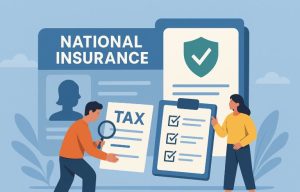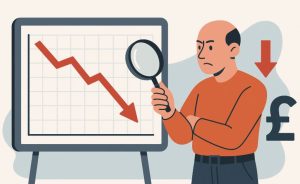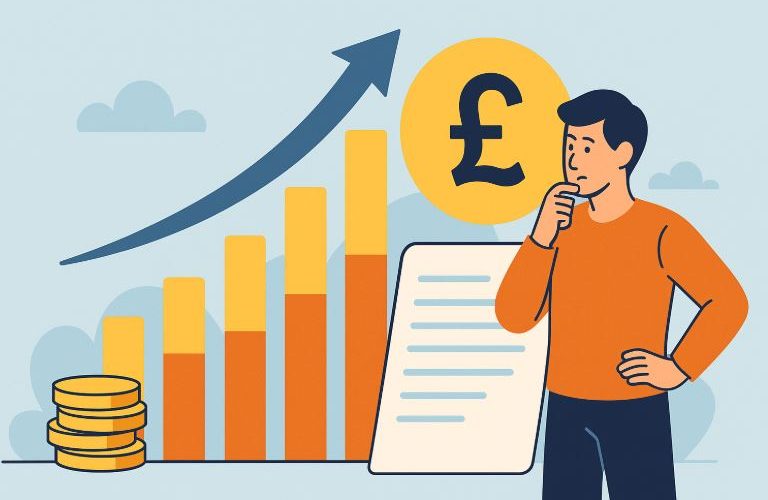For millions of people across the UK, the term “personal allowance” is not just financial jargon; it is a real figure that determines how much of their hard-earned money they get to keep. With the arrival of the 2025–2026 tax year, many are wondering: Is the UK personal allowance actually increasing?
At first glance, it might seem so. But look deeper, and the truth is more complicated. Behind the numbers are stories of rising living costs, fiscal policies, and government decisions that directly affect workers, families, pensioners, and businesses.
This blog takes you on a detailed, clear, and human explanation of why the UK personal allowance is positioned where it is for 2025, how it impacts everyday taxpayers, and what they can do to prepare.
What is the UK Personal Allowance for 2025?

The personal allowance is the amount of income you can earn each year before you start paying income tax. For the 2025–2026 tax year, the standard personal allowance remains:
- £242 per week
- £1,048 per month
- £12,570 per year
This applies to most taxpayers in England, Wales, and Northern Ireland. Scotland has its own tax bands, but the personal allowance is still the same.
Why Does the Personal Allowance Matter?
The personal allowance effectively determines your tax-free earnings. For example, if you earn £20,000, you only pay tax on £7,430 (after deducting the allowance). If you earn £50,000, you pay higher rates on the portion above the basic threshold.
It shapes the PAYE system, affects your take-home pay, and has consequences for everything from benefits to tax credits.
Special Cases
If you earn over £100,000, your personal allowance reduces by £1 for every £2 above this income, meaning it disappears entirely at £125,140. There are also extra allowances, like Blind Person’s Allowance, that can be added on top.
Is the UK Personal Allowance Increase 2025?
Many people assume that allowances increase automatically with inflation, but this is not the case in 2025. The personal allowance has been frozen at £12,570 since 2021 and will stay at this level until at least April 2028.
What Does the Freeze Mean?
While the figure stays the same, wages and prices rise. This creates fiscal drag, where more people are pulled into higher tax brackets even though tax rates themselves have not increased. Essentially, you end up paying more tax simply because your salary increased to keep up with living costs.
How Does This Compare Historically?
In past years, personal allowance increases were designed to match inflation, helping people maintain their purchasing power. Between 2010 and 2021, it grew steadily.
But now, the freeze means the real-world value of the allowance is shrinking, increasing the government’s tax revenue without officially raising tax rates.
Why is the Allowance Frozen Until 2028?
The freeze was introduced in the March 2021 Budget, initially set to end in 2026. But in the Autumn Statement 2022, the Chancellor extended it by two more years, until April 2028.
The Government’s Reason
The government argues that freezing thresholds is a way to help balance public finances after major spending, such as during the COVID-19 pandemic and the cost-of-living crisis. Estimates suggest this move will raise over £1.2 billion for the Treasury by 2028.
Impact on Taxpayers
This freeze affects all individual taxpayers across the UK. While income tax rates remain unchanged, the unchanged thresholds mean that as people’s wages rise, they slip into higher tax bands, paying proportionally more tax, a hidden or “stealth” tax in the eyes of critics.
How Does the Personal Allowance Affect PAYE and Tax Codes?

Most UK workers pay tax through the Pay As You Earn (PAYE) system, where employers deduct tax and National Insurance directly from wages.
How PAYE Works?
Employers use payroll software to calculate tax deductions based on an employee’s tax code and income over the personal allowance. The 2025–2026 standard tax code is 1257L, which also appears in emergency codes such as 1257L W1, 1257L M1, and 1257L X.
If you change jobs or your circumstances change, HMRC may apply an emergency tax code until everything is updated.
Why Tax Codes Matter?
A wrong tax code can lead to overpaying or underpaying tax. Employees should regularly check their tax code on payslips, especially if they have multiple income sources, benefits, or recent changes.
What Are the 2025 Income Tax Rates and Bands?
Here’s a detailed table comparing income tax across UK regions:
| Region | Personal Allowance | Basic Rate Band | Higher Rate Band | Additional Rate Band |
| England, NI, Wales | £12,570 | £12,571–£50,270 (20%) | £50,271–£125,140 (40%) | Over £125,140 (45%) |
| Scotland | £12,570 | Starter: up to £2,827 (19%) | Intermediate: £14,922–£31,092 (21%) | Top: Over £125,140 (48%) |
Key Differences
Scotland has extra bands, starter, intermediate, advanced, meaning higher earners face rates up to 48%. The rest of the UK sticks to the 20%, 40%, and 45% split.
How Does National Insurance Work in 2025?

National Insurance (NI) is another key deduction, funding things like the state pension and the NHS.
Employee NI Rates
| Category Letter | Up to £12,570 | £12,570–£50,270 | Over £50,270 |
| A | 0% | 8% | 2% |
| B | 0% | 1.85% | 2% |
| M (Under 21) | 0% | 8% | 2% |
Employer NI Rates
| Category Letter | Up to £50,270 | Over £50,270 |
| A, B, C, J | 15% | 15% |
| H (Apprentice) | 0% | 15% |
| V (Veteran) | 0% | 15% |
Employers and employees alike should monitor these, as they directly affect wage costs and take-home pay.
What About Minimum Wage and Statutory Payments?
From April 2025, the National Minimum Wage rises as follows:
| Category | Hourly Rate |
| Age 21+ | £12.21 |
| Age 18–20 | £10.00 |
| Under 18 | £7.55 |
| Apprentices | £7.55 |
Statutory Payments 2025
- Maternity, Paternity, Adoption, Shared Parental Pay: £187.18/week or 90% of average weekly earnings, whichever is lower
- Statutory Sick Pay: £118.75/week
Employers can recover up to 108.5% of statutory payments if their prior year’s NI contributions were under £45,000.
How Will Student Loans and Postgraduate Loans Be Deducted?
Student loan repayments are based on income.
| Loan Plan | Annual Threshold | Monthly Threshold | Repayment Rate |
| Plan 1 | £26,065 | £2,172.08 | 9% |
| Plan 2 | £28,470 | £2,372.50 | 9% |
| Plan 4 | £32,745 | £2,728.75 | 9% |
| Postgraduate | £21,000 | £1,750.00 | 6% |
Payroll Software Role
Employers are responsible for deducting the correct amounts automatically via payroll software.
Why Is the Additional Rate Threshold Lower?

The additional rate threshold was cut in April 2023 from £150,000 to £125,140.
Effect on High Earners
This change increases the number of people paying the top tax rate. For instance, someone earning £130,000 now pays 45% on £4,860. In Scotland, the top rate is even higher at 48%.
Fiscal Drag Again
As with the personal allowance freeze, reducing the additional rate threshold is another way the government increases tax receipts without changing headline rates.
How Should Individuals Plan Their Finances?
With frozen thresholds and rising incomes, tax planning becomes even more important.
Tips for Taxpayers
- Check your tax code and income band regularly
- Use pension contributions and ISAs to shelter income
- Consider the Marriage Allowance if your partner earns below the personal allowance
- Explore allowable expenses if you are self-employed
- Use trading and property allowances (£1,000 each) if eligible
What’s the Bigger Picture Behind the Allowance Freeze?
The personal allowance freeze has sparked debate.
Government View
The government says it helps raise needed funds while protecting public services without raising headline tax rates, keeping the economy stable after recent shocks.
Public and Expert Opinions
Critics see it as a hidden tax rise, disproportionately hitting middle earners. Petitions and calls to adjust thresholds in line with inflation have gained momentum.
Conclusion
In 2025, most people will see their tax-free allowance unchanged at £12,570. But rising incomes mean more will enter higher tax bands, paying more tax overall.
Combined with National Insurance, minimum wage changes, student loans, and statutory payments, the financial picture for households and businesses is increasingly complex.
Staying informed, planning ahead, and making use of all available allowances and reliefs is essential for navigating this challenging but manageable tax landscape.
FAQs
Should I update my tax code in 2025?
It is good practice to check your tax code, but HMRC usually updates it automatically unless your situation has changed.
Does the frozen allowance mean I pay more tax?
Yes, as your income rises, more of it becomes taxable without the threshold increasing, leading to higher tax bills.
How is National Insurance changing in 2025?
The thresholds are aligned with the personal allowance, but the rates differ by category, so employees and employers should review contributions.
Will the minimum wage increase cover inflation?
It helps, but many argue it does not fully cover rising living costs, especially with housing, energy, and food price increases.
Who qualifies for employment allowance?
Small businesses and charities can reduce their NI bills by up to £10,500 per year if eligible.
Are student loan repayments affected by the allowance freeze?
Not directly, but as wages rise, more income is subject to student loan deductions.
How can I reduce my tax bill in 2025?
Pension contributions, ISAs, Marriage Allowance, and careful tax planning can all help reduce your overall tax burden.








